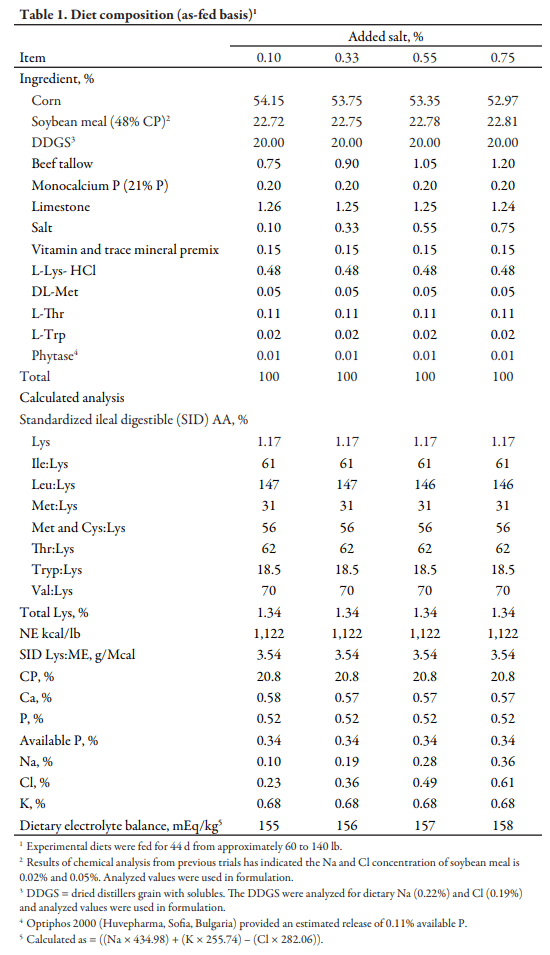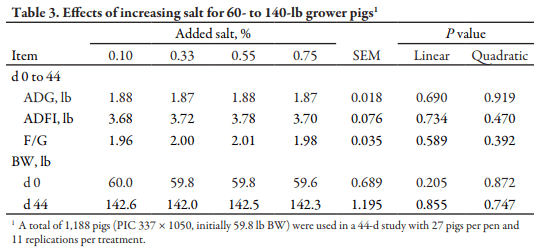Introduction
Sodium and chloride are involved in several of the body’s processes, such as the sodium potassium pump and osmotic regulation. Traditionally, the most common source of Na and Cl in swine diets is added salt. Hagsten et al. noted improvements in ADG and F/G when at least 0.10% of salt was added to corn-soybean meal diets for pigs from 40 to 200 lb. However, Alcantara et al. reported that in corn-soybean meal diets for growing pigs (55 to 110 lb), ADG and ADFI improved up to 0.08% added salt, with no further responses to higher salt additions. Honeyfield et al. observed improvements in ADG, ADFI, and F/G as the Na and Cl concentration was increased up to 0.18% and 0.08%, respectively, in corn-soybean meal diets or the equivalent of approximately 0.40% added salt (to meet the Na estimate).
The NRC requirement estimates for Na and Cl are 0.10 and 0.08%, respectively, for 50- to 165-lb pigs. Typically, most grower diets will contain a fixed amount of 0.35 to 0.50% of salt to meet the requirement estimate but this may result in Na and Cl concentrations exceeding the NRC requirement estimate. Therefore, the objective of this study was to determine the dietary salt requirements for pigs weighing 60 to 140 lb in a commercial setting.
Procedures
The Kansas State University Institutional Animal Care and Use Committee approved the protocol used in this study. The experiment was conducted at a commercial research-finishing site in southwest Minnesota. Pigs were housed in a naturally ventilated and double-curtain-sided barn. Each pen (10 × 18 ft) contained a 4-hole stainless steel feeder and cup waterer for ad libitum access to feed and water. Feed additions to each individual pen were made and recorded by a robotic feeding system (FeedPro; Feedlogic Corp., Wilmar, MN).
A total of 1,188 pigs (PIC 359 × 1050; initial BW 59.8 lb) were used in a 44-d growth trial with 27 pigs per pen and 11 pens per treatment. Pens were blocked by BW and then randomly assigned to 1 of 4 dietary treatments in a completely randomized block design. Dietary treatments were corn-soybean meal-based and contained either 0.10, 0.33, 0.55, and 0.75% added salt (Table 1), which resulted in calculated dietary Na levels of 0.10, 0.19, 0.28, and 0.36% and calculated Cl levels of 0.23, 0.36, 0.49, and 0.61%. Pens of pigs were weighed and feed disappearance was recorded on d 0, 16, 31, and 44 of the trail to determine ADG, ADFI, and F/G.
Diet samples were taken from the feeder at the beginning and the end of the trial, pooled, and subsampled. Subsamples were analyzed for DM, CP, Na, and Cl (Ward Laboratories, Inc., Kearney, NE, Table 2).
Data were analyzed as a completely randomized block design using PROC GLIMMIX in SAS version 9.4 (SAS Institute, Inc., Cary, NC) with pen as the experimental unit. Linear and quadratic polynomials were used to evaluate increasing levels of added salt. Results were considered significant at P ≤ 0.05 and marginally significant between P > 0.05 and P ≤ 0.10.
Results and Discussion
Chemical analysis indicated that calculated values for Na and Cl were similar to analyzed values. Sodium ranged from 0.11 to 0.34% and Cl ranged from 0.26 to 0.61% (Table 2).
For the overall study (d 0 to 44), there was no evidence of difference to indicate that increasing salt beyond 0.10% improved ADG, ADFI, F/G, or d 44 BW (Table 3).
According to the chemical analysis, the 0.10% added salt diet had a Na concentration of 0.11% and a Cl concentration of 0.26%. The 0.10% added salt diet would have a similar Na concentration to the NRC requirement estimate of 0.10% but would be slightly lower than the optimal concentration reported by Honeyfield et al. which was 0.18%. The 0.10% added salt diet had a Cl concentration that was significantly greater than the requirement reported by Honeyfield et al. of 0.08% and the NRC requirement estimate of 0.08%. The 0.10% of added salt diet would agree with the optimal inclusion reported Hagsten et al., which was 0.10%, and was also similar to the ideal inclusion observed by Alcantara et al., which was 0.08%; however, their diets did not include dried distillers grain with solubles as in our experiment. In conclusion, 0.10% of added salt in a corn-soybean meal diet containing 20% dried distillers grain with solubles was adequate for maximum ADG, ADFI, and F/G in 60- to 140-lb grower pigs.



This article was originally published in Kansas Agricultural Experiment Station Research Reports: Vol. 3: Iss. 7. https://doi.org/10.4148/2378-5977.7486. This is an Open Access articles licensed under a Creative Commons Attribution 4.0 License. 












.jpg&w=3840&q=75)